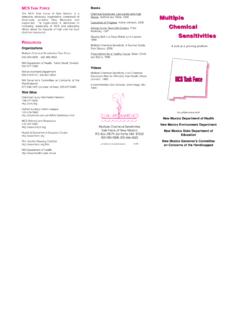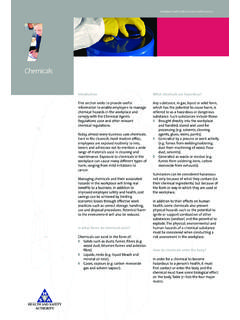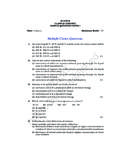Transcription of Understanding & Accommodating People with …
1 Understanding & Accommodating People with multiple chemical Sensitivity in Independent Living By Pamela Reed Gibson, James Madison University 2002 ILRU 2323 S. Shepherd, Suite 1000 Houston, Texas 77019 713-520-0232 (V) 713-520-5136 (TTY) 713-520-5785 (Fax) IL NET Director: Richard Petty Design: Kaye Beneke ILRU Publications Team: Carri George, Dawn Heinsohn and Rose Shepard Substantial support for development of this publication was provided by the Rehabilitation Services Administration, Department of Education. No official endorsement of the Department of Education should be inferred. The IL NET is a collaborative project of Independent Living Research Utilization (ILRU) and the National Council on Independent Living (NCIL), with funding from the Rehabilitation Services Administration. ILRU is a program of The Institute for Rehabilitation and Research (TIRR), a nationally recognized, freestanding medical rehabilitation facility for persons with physical and cognitive disabilities.
2 TIRR is part of TIRR Systems, which is a not-for-profit corporation dedicated to providing a continuum of services to individuals with disabilities. This guide may be reproduced for noncommercial use without prior permission if the author and ILRU are cited. Table of Contents Understanding and Accommodating People with multiple chemical Sensitivity in Independent Living AN INTRODUCTION TO MCS AND ES .. 2 Description .. 2 Causes/Hypotheses About How MCS Develops .. 3 Prevalence .. 5 Cultural Response .. 5 How to Help .. 6 THE HEALTH CARE CHALLENGE IN MCS .. 7 How to Help .. 9 THE EMPLOYMENT CHALLENGE IN MCS .. 11 Holding Onto Employment for Those with MCS .. 11 Getting Compensation for MCS .. 13 HOW TO HELP ..15 THE HOUSING CHALLENGE IN MCS ..16 Current Housing Conditions for Those with MCS ..16 How Does One Create A Safe Living Space?.
3 18 How to Help .. 19 ACCESS TO People AND PLACES .. 21 Access to People .. 21 Access to Places .. 22 How to Help .. 23 IDENTITY, SELF, AND PSYCHOLOGY IN MCS .. 24 Psychological Consequences of MCS .. 24 Self and Identity in MCS .. 26 How to Help .. 26 CONCLUSION .. 28 ABOUT THE AUTHOR .. 29 Accommodating People with MCS Page 1 Acknowledgements I want to thank the IL NET partners, ILRU and NCIL, for their support and their commitment to this project. I am encouraged by the apparent growing interest in the IL field in being inclusive of persons with all types of disabilities. I hope this booklet will be of service to both centers for independent living and consumer alike. I also want to thank Ann McCampbell, and Darrell Jones for their detailed editorial assistance and suggestions. And thanks to Susan Molloy, for helpful feedback on selected chapters and input about Electrical Sensitivity.
4 Accommodating People with MCS Page 2 CHAPTER 1 AN INTRODUCTION TO MCS AND ES Description In multiple chemical sensitivity (MCS) a person develops markedly negative reactions to everyday chemical exposures. These include exposures to pesticides in buildings, in gardens, on our food, and on pets; chemical cleaners; petrochemical heating systems; paints; perfumes; industrial emissions; and a myriad of others. We have been conditioned to think of these exposures as being normal and inconsequential, but for a growing portion of the population they are not. The condition of MCS develops in two stages induction and triggering. In induction some contact with chemicals causes the person to sensitize to at least one class of chemicals. This contact can be one large chemical exposure such as a chemical spill or a pesticide application, or it can be a low-level, ongoing exposure such as one might experience in a workplace with poor ventilation combined with copy fumes, perfume, and chemical cleaners.
5 After induction the person develops sensitivity to the chemical that was involved in the exposure and to other related chemicals. Thereafter the person will respond with symptoms when exposed to any of this class of chemicals. This is called triggering. The sensitivities developed are usually more or less permanent, although the kind and intensity of reactions may vary. In what is called the spreading phenomenon the sensitivities tend to spread over time to other related chemicals and also to other classes of chemicals. The primary way to avoid reactions once sensitivities have developed is to avoid contact with the triggers. with each new sensitivity this becomes more difficult and the person s access becomes more limited. For this reason one of the major goals in helping People with MCS is to try to limit the spreading by reducing chemical exposures in order to preserve what tolerance the person still has.
6 Unfortunately it is not unusual for People developing MCS to continue to expose themselves to chemicals because at first they do not link their reactions to chemical exposures and/or do not know that repeated exposures can cause a worsening or spreading of their sensitivities. Although less is known about electrical sensitivities (ES), People who experience them report that they develop in much the same way as MCS. An initiating exposure to an electrical field causes the sensitization, which then sets the person up to experience negative health effects in response to any future contact with electrical fields or radiation. Avoidance of electrical fields is then necessary in order to avoid debilitating health reactions. What Kinds of Negative Health Reactions Occur? MCS symptoms can affect any organ system including respiratory, digestive, neurological, endocrine, urinary, cardiovascular, or immune.
7 The health problems experienced from each trigger vary from person to person, but tend to be stable for each person with each trigger. This means that one person may have a constellation of symptoms from petrochemical exposure such as vehicle exhaust that includes headache, confusion, dizziness, and nausea. This constellation occurs each time that person has a petrochemical exposure. There are many symptoms that People can experience from chemical exposure. The five most common symptoms in my research were tiredness/lethargy, difficulty concentrating, muscle aches, memory difficulties, and long-term fatigue. This suggests overlap with chronic fatigue syndrome. Other commonly reported symptoms include digestive problems, joint pain, headache, irritability, tenseness, spacey feelings, insomnia, depression, difficulty making decisions, pressure in the head, rhinitis, sleepiness, eye irritation, coordination problems, dizziness, slow response, chest pain, tingling fingers and toes, nausea, rashes, and hives.
8 Symptoms from electrical sensitivities may include loss of muscle control, noise sensitivity, and other neurological problems. Accommodating People with MCS Page 3 The health problems triggered by chemicals in People with MCS vary from mild to life threatening, and for some pose very alarming situations. For example one woman in my study gets dangerous blood clots from chemical exposures. An environmental physician described to me a patient whose heart stops in public if she is exposed to chemicals. She has to have someone start it again. Which Chemicals Cause the Most Problems? In my research, respondents rated pesticides, formaldehyde, fresh paint, new carpets, diesel exhaust, perfumes, and air fresheners as being the most troublesome chemical exposures. This is congruent with other studies. Other triggers that are rated as being very problematic in various studies include tobacco smoke, fresh asphalt, moth balls, nail polish and remover, phenol, fabric softener, furniture polish, dry cleaning chemicals, hair spray, new vinyl plastic, chlorine bleach, auto exhaust, laundry detergent, natural gas, shampoos and conditioners, and newsprint.
9 It is also common for People to suffer from inhalant allergies to pollens and molds, or from food allergies. These problems further impair People s functioning. In addition, some People s lives are complicated by sensitivities to electromagnetic frequencies (EMFs), emitted by high-tension wires, transmitters, and other large sources of electricity as well as electrical appliances and other small sources found in the home. Although electrical sensitivity is less understood and accepted than MCS, there are some studies now that show that EMFs can alter the permeability of neurons, thereby affecting the levels and circulation of brain chemicals (neurotransmitters). In a number of these studies, EMFs also have been linked to cancer (particularly in children) (Pinsky 1995). I have seen a person with EMF sensitivity lose the ability to walk within seconds of exposure to fluorescent lighting.
10 One moment she was walking fine and the next she appeared to have cerebral palsy simply from entering a building with this type of lighting. Are These Reactions to Chemicals a New Medical Condition? Although MCS still is not officially recognized by the medical establishment in the , illness reactions from chemicals, particularly petrochemicals, are not new. Theron Randolph, , thought to be the Father of Environmental Medicine was studying allergic reactions to petrochemicals in the l950s, and called this problem The Petrochemical Problem. As in the case of most visionaries, he was punished rather than rewarded for his work. He was fired from the University of Chicago School of Medicine for being a pernicious influence upon students. Randolph s book An Alternative Approach to Allergies, written with Ralph Moss, describes his early work, his theories, and the basic tenets of Environmental Medicine.








